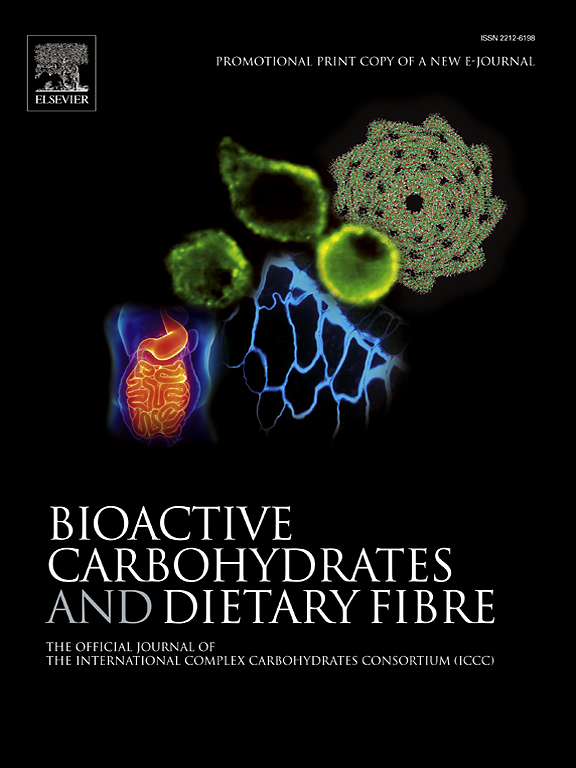Semisynthetic and amylase-treated Taraxacum officinale galactans: Combat colorectal cancer with cytokine modifier response
IF 3.6
引用次数: 0
Abstract
Polysaccharides are naturally abundant, biodegradable, and cost-effective sustainable biomaterials. However, their limited pharmacodynamic properties often hinder clinical efficacy. Hence, structural modifications of polysaccharides can enhance their therapeutic efficacy in response to application demands. In this study, a galactan polysaccharide (TOP50) was purified from Taraxacum officinale, and three derivatives were prepared by sulfation (STOP50), acetylation (ACTOP50), and enzymatic hydrolysis using amylase (TOP50am). The physicochemical properties were investigated using gas chromatography, size-exclusion chromatography, linkage analysis, infrared spectroscopy, scanning electron microscopy, and 1H NMR spectroscopy, alongside the determination of the degree of substitution (DSS). The cytotoxic activities of the native and modified polysaccharides were evaluated against colorectal cancer cell lines (HT-29, HCT-116, and RKO), and their immunomodulatory effects were assessed by measuring cytokine levels (IL-6, IL-8, IL-10, and IL-12). Native TOP50 (50 kDa) was identified as a pectic galactan with a chain of 4-linked glucoses (4-Glc), 3,6-linked galactose (3,6-Gal), terminal galactopyranosyl (t-Gal), and glucopyranosyl (t-Glc) residues. Among the derivatives, STOP50 exhibited the most pronounced cytotoxic effect on RKO cells. Both STOP50 and TOP50am markedly suppressed the expression of pro-inflammatory cytokines IL-8 and IL-10 while significantly enhancing IL-12 production. Remarkably, TOP50am induced a 15-fold upregulation of IL-12, indicating its potent immunostimulatory effects. These findings highlight the potential of structurally modified T. officinale galactans as multifunctional anticancer agents, supporting their potential in colorectal cancer therapy. The elucidated structure–activity relationships serve as a pivotal basis for developing polysaccharide-based therapeutics aimed at modulating tumor growth and regulating immune responses.
半合成和淀粉酶处理的蒲公英半乳:与细胞因子修饰剂反应对抗结直肠癌
多糖是天然丰富的、可生物降解的、具有成本效益的可持续生物材料。然而,它们有限的药效学特性往往阻碍了临床疗效。因此,多糖的结构修饰可以根据应用需求提高其治疗效果。本研究从蒲鲁英中纯化了一种半乳聚糖(TOP50),并通过磺化(STOP50)、乙酰化(ACTOP50)和淀粉酶水解(TOP50am)制备了三种半乳聚糖衍生物。采用气相色谱法、排粒径色谱法、连锁分析、红外光谱、扫描电镜、1H NMR等方法对其理化性质进行了研究,并测定了取代度(DSS)。通过测定细胞因子(IL-6、IL-8、IL-10和IL-12)水平,研究了天然多糖和改性多糖对大肠癌细胞株(HT-29、HCT-116和RKO)的细胞毒活性,以及免疫调节作用。原生TOP50 (50 kDa)被鉴定为一种果胶半乳糖,具有4-链葡萄糖(4-Glc)、3,6-链半乳糖(3,6- gal)、末端半乳糖酰氨基(t-Gal)和葡萄糖酰氨基(t-Glc)残基。其中,STOP50对RKO细胞的细胞毒作用最为显著。STOP50和TOP50am均能显著抑制促炎细胞因子IL-8和IL-10的表达,同时显著提高IL-12的产生。值得注意的是,TOP50am诱导IL-12上调15倍,表明其有效的免疫刺激作用。这些发现强调了结构修饰的T. officinale半乳糖作为多功能抗癌药物的潜力,支持了它们在结直肠癌治疗中的潜力。阐明的结构-活性关系为开发以多糖为基础的治疗药物提供了关键基础,旨在调节肿瘤生长和调节免疫反应。
本文章由计算机程序翻译,如有差异,请以英文原文为准。
求助全文
约1分钟内获得全文
求助全文
来源期刊

Bioactive Carbohydrates and Dietary Fibre
Agricultural and Biological Sciences-Food Science
CiteScore
6.00
自引率
0.00%
发文量
38
期刊介绍:
 求助内容:
求助内容: 应助结果提醒方式:
应助结果提醒方式:


